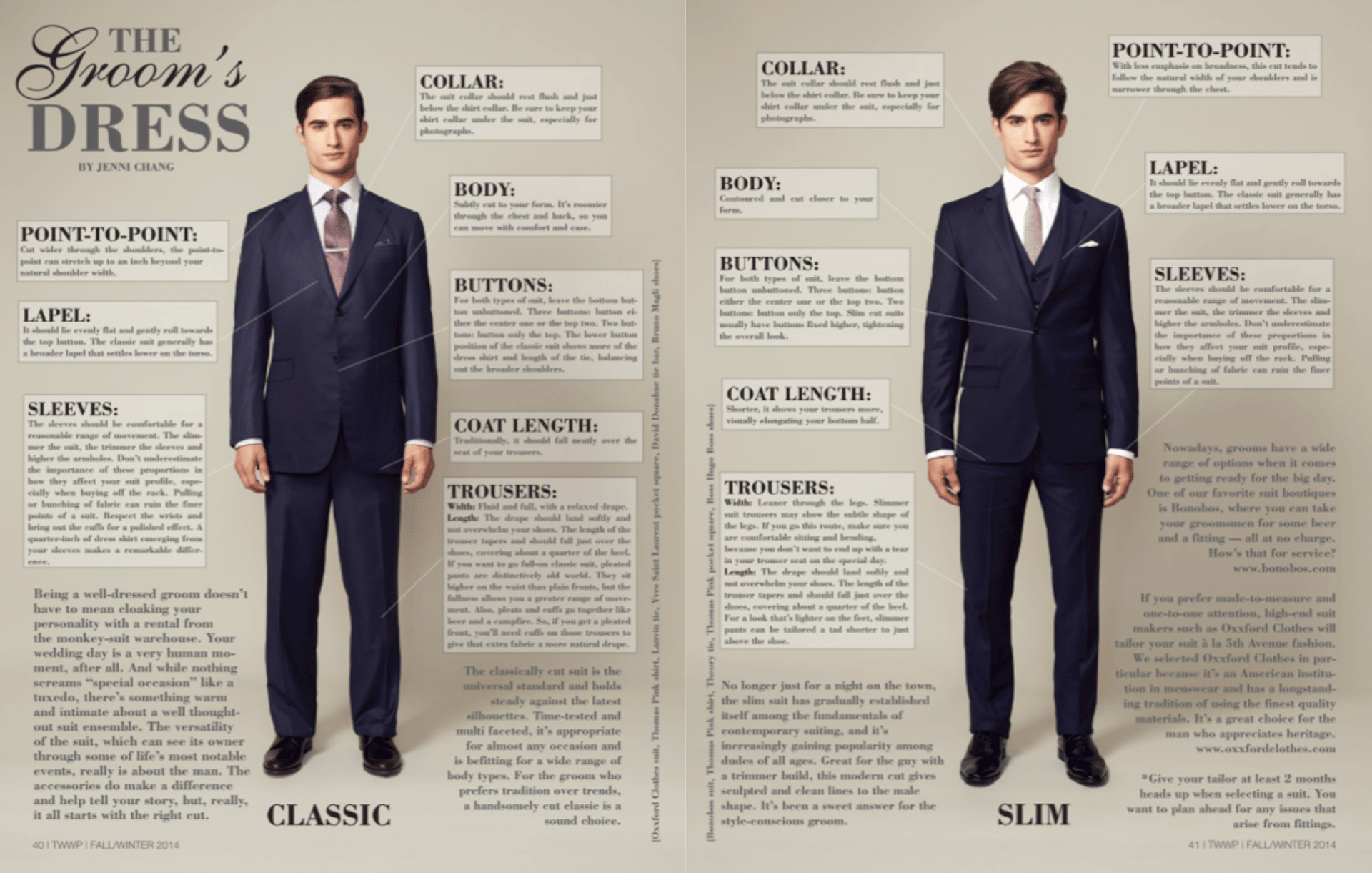The Groom's Dress
By Jenni Chang
Featured in The Westchester Wedding Planner

The Groom’s Dress
By Jenni Chang
Being a well-dressed groom doesn’t have to mean cloaking your personality with a rental from the monkey-suit warehouse. Your wedding day is very human moment after all. And while nothing screams “special occasion” like a tuxedo, there’s something warm and intimate about a well thought-out suit ensemble. The versatility of the suit, which can see its owner through some of life’s most notable events, really is about the man. The accessories do make a difference and help tell your story but, really, it all starts with the right cut.
There are two general tendencies when it comes to suits: Classic and Slim.
The Classic Suit
The classically cut suit is the universal standard and holds steady against the latest silhouettes. Time tested and multi-faceted, it’s appropriate for almost any occasion and is befitting for a wide range of body types. For the groom who prefers tradition over trends, a handsomely-cut classic is a sound choice.
The Slim Suit
No longer just for a night on the town, the slim suit has gradually established itself among the fundamentals of contemporary suiting. And it’s increasingly gaining popularity among dudes of all ages. Great for the guy with a trimmer build, this modern cut gives sculpted and clean lines to the male shape. It’s been a sweet answer for the style-conscious groom.
Characteristics of a Suit
Point-to-Point: This is the width of the seams at the top of the shoulders.
Classic: Cut wider through the shoulders, the point-to-point can stretch up to an inch beyond your natural shoulder width.
Slim: With less emphasis on broadness, this cut tends to follow the natural width of your shoulders and is narrower through the chest.
Collar (classic and slim): The suit collar should rest flush and just below the shirt collar. Be sure to keep your shirt collar under the suit, especially for photographs.
Lapel (classic and slim): It should lie evenly flat and gently roll towards the top button. The classic suit generally has a broader lapel that settles lower on the torso.
Buttons: For both types of suits, leave the bottom button unbuttoned.
Three buttons: Button either the center one or the top two.
Two buttons: Button only the top.
Sleeves: The sleeves should be comfortable for a reasonable range of movement. The slimmer the suit, the trimmer the sleeves and higher the armholes. Don’t underestimate the importance of these proportions in how they affect your suit profile, especially when buying off the rack. Pulling or bunching of fabric can ruin the finer point of a suit.
Respect the wrists and bring out the cuffs for a polished effect. A quarter-inch of dress shirt emerging from your sleeves makes a remarkable difference.
Button Placement: Button placement is important to how the suit frames the tie and shirt.
Classic: The lower button position of the classic suit shows more of the dress shirt and length of the tie, balancing out the broader shoulders.
Slim cut suits usually have buttons fixed higher, tightening the overall look.
Body
Classic: Subtly cut to your form. It’s roomier through the chest and back, so you can move with comfort and ease
Slim: Contoured and cut closer to your form
Coat length
Classic: Traditionally, it should fall neatly over the seat of your trousers
Slim: Shorter, it shows your trousers more, visually elongating your bottom half
Trousers
Width
Classic: Fluid and full, with a relaxed drape
Slim: Leaner through the legs
Slimmer suit trousers may show the subtle shape of the legs. If you go this route, make sure you are comfortable sitting and bending, because you don’t want to end up with a tear in your trouser seat on the special day.
Length:
Both classic and slim: The drape should land softly and not overwhelm your shoes.
The length of the trouser tapers and should fall just over the shoes, covering about a quarter of the heel.
Slim: For a look that’s lighter on the feet, slimmer pants can be tailored a tad shorter
to just above the shoe.
Classic: If you want to go full-on classic suit, pleated pants are distinctively old
world. They sit higher on the waist than plain fronts, but the fullness allows you
a greater range of movement. Also, pleats and cuffs go together like beer and a
campfire. So if you get a pleated front, you’ll need cuffs on those trousers to give that
extra fabric a more natural drape.
The Three-Piece Suit: Consider the Waistcoat
There’s a sartorial solidarity about the three-piece ensemble. It embraces formal occasions with vigor and distinction. Plus, the waistcoat (also known as the vest) is a welcome layer for those autumn and winter weddings. Have the piece fitted to your body and you’ll look pulled-together even sans coat.
Tips:
Nowadays, grooms have a wide range of options when it comes to getting ready for the big day. One of our favorite suit boutiques is Bonobos, where you can take your groomsmen for some beer and a fitting--all at no charge. How’s that for service?
www.bonobos.com
If you prefer made-to-measure and one-to-one attention, high-end suit makers such as Oxxford Clothes will tailor your suit a la 5th Avenue fashion. We selected Oxxford Clothes in particular, because it’s an American institution in menswear and has longstanding tradition of using the finest quality materials. It’s a great choice for the man who appreciates heritage.
www.oxxfordclothes.com
*Give your tailor at least 2 months heads up when selecting a suit. You want to plan ahead for any issues that arise from fittings.
Credits
By Jenni Chang
(no photographer credit please)
Classic:
Oxxford Clothes suit, Thomas Pink shirt, Lanvin tie, Yves Saint Laurent pocket square, David Donahue tie bar, Bruno Magli shoes
Slim:
Bonobos suit, Thomas Pink shirt, Theory tie, Thomas Pink pocket square, Boss Hugo Boss shoes
